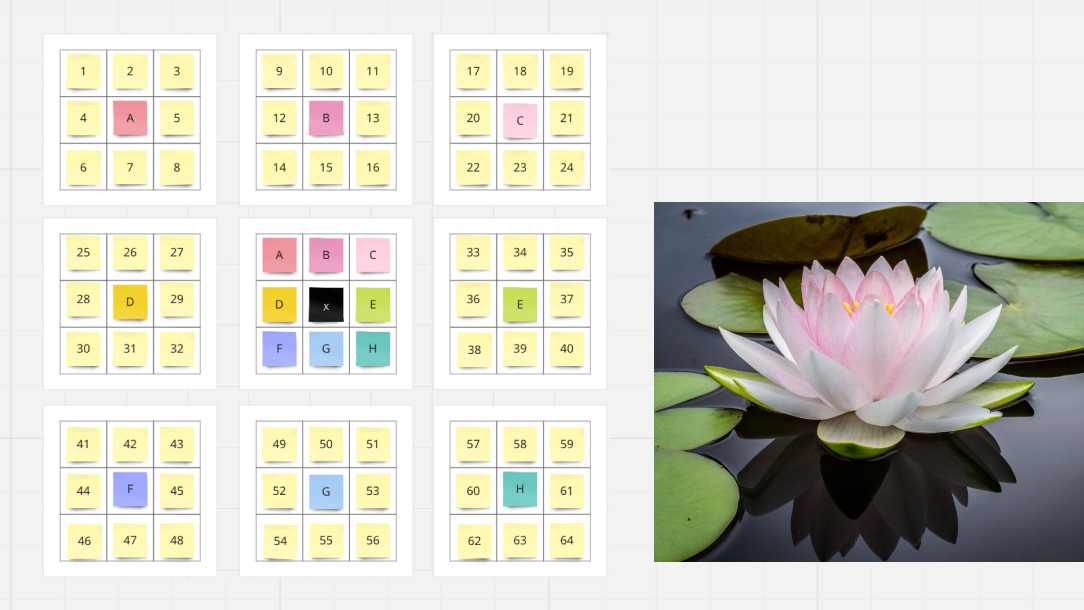The Lotus Blossom: A Creative Thinking Tool for Everyone
Ideation is often the most exciting stage in a product development project. As a Product Designer, you have the opportunity to generate a multitude of ideas that can inspire new and better design solutions. However, choosing the right ideation session format for a diverse audience can be challenging, especially when senior stakeholders, product managers, or developers, who may not regularly engage in creative thinking, are present. In such cases, the Lotus Blossom technique can be valuable in your ideation toolkit.
Where did it come from?
The Lotus Blossom technique is a structured and systematic approach to idea generation. Originating from Japan, this method provides a framework for organized brainstorming and encourages diverse thinking. By following a step-by-step process, participants can explore ideas in a methodical manner, even if they are not accustomed to flexing their creative muscles regularly.
How does it work?
1. Start with a core problem
The Lotus Blossom technique begins with a central problem statement or question. From there, participants brainstorm eight related themes or aspects of the problem.
2. Brainstorm related themes, solutions or components
These themes are then placed in a 3x3 grid, with the central problem statement in the centre box. Participants then brainstorm eight ideas for each of the eight themes, resulting in a total of 72 ideas.
2a. S.C.A.M.P.E.R.
SCAMPER is a quick, easy and direct form of creative brainstorming. You use the tool by asking questions about existing products, using each of the seven prompts above. These questions help you come up with creative ideas for developing new products, and for improving current ones.
Substitute
Combine
Adapt
Modify
Put to another use
Eliminate
Reverse
3. Break up into sub-problems and brainstorm again
These themes are then placed in a 3x3 grid, with the central problem statement in the centre box. Participants then brainstorm eight ideas for each of the eight themes, resulting in a total of 72 ideas.
Following up:
64 ideas is a lot. Your best bet is to prioritise the ideas, you can use a matrix like these ones recommended here, and make sure to include a tech and business opinion to understand feasibility and viability. Take those prioritised ideas and work closely with designers on Crazy 8’s or design jam sessions to create some wireframes and figure out how they’ll work within your product.
How does it work?
Application in Ideation Sessions:
Drawing from personal experience, the Lotus Blossom technique has proven effective in diverse ideation sessions. Whether participating in a Google-led sprint for a large-scale project or collaborating with founders with limited experience in creative fields, the Lotus Blossom technique fosters collaboration and ensures all team members can contribute effectively.
In one example, I used the Lotus Blossom technique to lead an ideation session for a new product launch. The team included senior stakeholders, product managers, and developers, who had different levels of experience with creative thinking. I started by setting the scene and providing context for the session. Then, I facilitated a warm-up exercise to help participants get into a creative mindset.
Once the team was warmed up, we began brainstorming the central problem statement. We identified eight related themes, and then brainstormed eight ideas for each theme. By the end of the session, we had generated 72 ideas, which we then evaluated and prioritized.
The Lotus Blossom technique was a valuable tool for this ideation session. It helped to ensure that all team members had a voice, and it resulted in a large pool of ideas to choose from. The team was able to select a few promising ideas to move forward with, and the product launch was a success.
Benefits and Results:
The Lotus Blossom technique yields numerous benefits. By completing the session entirely, participants can generate a remarkable 64 high-level ideas to move forward with. This abundance of ideas provides a rich pool of options for evaluation and selection, ensuring the ideation session is highly productive and fulfilling for everyone involved.
In addition to the sheer number of ideas, the Lotus Blossom technique also has the following benefits:
It encourages diverse thinking. By brainstorming eight related themes, participants are forced to think outside the box and consider a variety of perspectives.
It fosters collaboration. The Lotus Blossom technique is a team-based activity, which encourages participants to share ideas and build on each other's contributions.
It is easy to follow. The Lotus Blossom technique is a structured and systematic approach to idea generation, which makes it easy for participants to follow and participate.
Tips and Recommendations:
To maximize the effectiveness of the Lotus Blossom technique in ideation sessions, it is essential to set the scene, provide ample context, and establish a clear problem statement. Warm-up exercises and icebreakers help stimulate creativity and create a positive, energized atmosphere.
Additionally, providing stimulus materials and encouraging participants to bring their own ideas and examples further inspires innovation. Assigning asynchronous homework before the session ensures participants come prepared with additional insights and ideas.
Conclusion:
The Lotus Blossom technique offers a structured and systematic approach to ideation, enabling Product Designers to overcome challenges in diverse ideation sessions. By implementing this technique, you can foster collaboration, encourage diverse thinking, and generate a wealth of ideas for innovative design solutions. Embrace the power of the Lotus Blossom technique, and watch as your ideation sessions flourish, delivering exceptional results for your products and designs.




